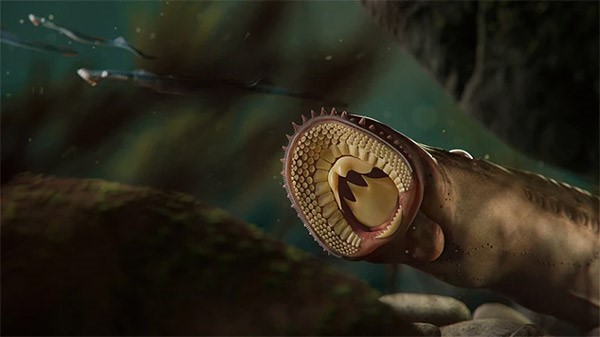Hello Nature readers, would you like to get this Briefing in your inbox free every day? Sign up here.
Jurassic lampreys (artist’s impression) used their toothed suckers to consume the flesh of their prey, a strategy that allowed them to grow larger than creatures that came before. (Heming Zhang)
Lampreys had flesh-eating ancestors
Two superbly preserved Jurassic fossils suggest that the ancestors of lampreys — one of two surviving lineages of the once-diverse group of jawless fishes — were fearsome, flesh-eating predators. The discovery also hints that lampreys have evolved different life strategies over time. “Apparently, lampreys have been gradually evolving, not as unchanged as we once believed,” says palaeobiologist Miao Desui.
Nature | 5 min read
Reference: Nature Communications paper
Dengue outbreaks in Europe
A post-pandemic increase in international travel has contributed to a surge in dengue in parts of southern Europe, where it had not been recorded previously. The long and warm summer is also to blame: it allowed tiger mosquitoes (Aedes albopictus), which inhabit southern Europe and can carry the disease, to thrive. Most people who catch dengue have no symptoms, but it can cause fever, headaches and fatigue, and kills as many as 40,000 people each year. Because the European outbreaks are small, scientists don’t expect dengue to become endemic there — at least, not anytime soon.
Nature | 6 min read
NASA can’t get the lid off of asteroid sample
NASA scientists are struggling to open the container that holds most of the dust and rocks snatched from the asteroid Bennu and returned to Earth by the OSIRIS-REx mission. Two of the 35 fasteners are stuck, says NASA — and they can’t just run the lid under hot water. The container is kept in a specialized glovebox under a flow of nitrogen to keep it from being exposed to Earth’s atmosphere. And they can use only carefully prepared tools that fit inside and won’t contaminate the material. But the mission has already overdelivered: the team has scraped more than its goal — 60 grams of material — off the outside of the lid.
Space.com | 6 min read
Features & opinion
Why no one knows how psychedelics work
Psychedelic-assisted treatments for trauma and depression are speeding towards approval in the United States. Yet what chemicals such as MDMA and psilocybin actually do in the brain is still largely a mystery. They seem to facilitate the rewiring of neural connections — but the nature of this plasticity is hotly debated. “People talk about plasticity like there’s an understood meaning everyone agrees upon,” says psychiatrist Gerard Sanacora. “It’s a huge black box.”
Nature | 11 min read
Garbage in, garbage out: how to trust AI
Artificial-intelligence (AI) tools are transforming data-driven science — but, when used wrongly, they can deliver unreliable results and even cause unintended harm. Here are some tips for helping to build trust in AI-derived findings, from a group of space, Earth and environmental scientists:
• Watch out for gaps and biases in training data
• Clearly explain how AI-generated results were reached
• Ensure transparency by sharing code, risks and uncertainties
• Consider using open data repositories
Nature | 12 min read
The global AI summit is missing the point
Innovation, not regulation, seems to be the focus at this week’s AI Safety Summit, to which the UK government invited influential figures from industry, policy and research. Meanwhile, many scientists are gathering for a separate ‘fringe’ event. Robust regulation of AI technologies needs to be led by researchers, who “should have been front and centre at the summit”, argues a Nature editorial.
Nature | 6 min read
How to support Sudan’s displaced scientists
Civil war in Sudan has displaced millions of people, and more than 100 universities have been destroyed, looted or extensively damaged. “Displaced Sudanese researchers and students urgently need support from the global scientific community,” writes Mohamed Hassan, president of the Sudanese National Academy of Sciences. He outlines how researchers, institutions and funding agencies can help by hosting fellowships and programmes abroad.
Nature | 5 min read
Image of the week

This video shows chemical signals passing along the leaves of an Arabidopsis thaliana plant as it senses the airborne volatile organic compounds (Z)-3-hexenal and (E)-2-hexenal, which are released by damaged plants.
The signals are carried by calcium ions. Researchers have developed a way to visualize the warning process by labelling calcium with a fluorescent protein. The plants’ ability to detect their neighbours’ warning messages allows them to activate defences against herbivores. (Reference: Nature paper)
See more of the month’s sharpest science shots, selected by Nature’s photo team. (Masatsugu Toyota/Saitama University)
